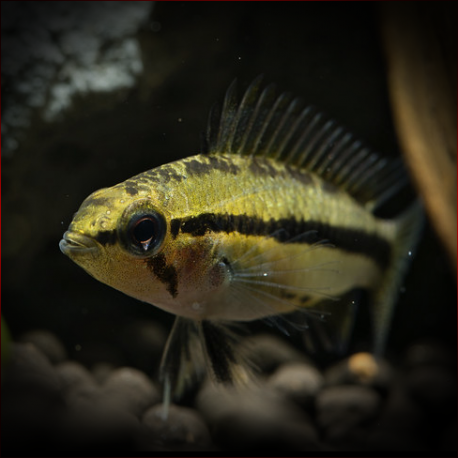More info
Datasheet
| Minimum Tank Size | 40 litres / 10.57 US gallons |
| Maximum Size | 5.5cm / 2.17inches |
| Temperature | 20°C / 68.00°F - 25°C / 77.00°F |
| Hardness | 1.01dgH / 18ppm - 10.03dgH / 179ppm |
| pH | 5.0-7.0 |
General Description
The Three-Striped Apisto, also known as A204, is a member of the Cichlidae family and belongs to the Perciformes classification order. These fish are relatively small, reaching up to 5.5cm in size. They are predominantly carnivorous, consuming benthic invertebrates in their natural habitat.
Aquarium Setup
For the optimal care of Three-Striped Apistos, a tank size of at least 40 liters is recommended. The setup should include ample hiding spots provided by ceramic flowerpots, plastic piping, and natural decor like wood roots and branches. Adding leaf litter can offer cover and spawning sites while promoting the growth of beneficial microorganisms. Dim lighting, aquatic plants such as Microsorum and Cryptocoryne spp., and a gentle filtration system are essential. Maintaining soft, acidic water within a pH range of 5.0-7.0 is crucial for their well-being.
Behaviour
In captivity, it is advisable to choose captive-raised Three-Striped Apistos for community tanks. Wild-caught specimens are best kept either alone or with small 'dither' fish like Nannostomus spp. They are territorial during breeding, with males displaying colorful patterns and extended fins.
Feeding and Diet
Their diet mainly comprises live and frozen foods such as Artemia, Daphnia, Moina, and chironomid larvae. Although they prefer these protein-rich options, they can also acclimate to pelleted food over time. Feeding a varied diet is essential for their health and vibrancy.
Reproduction & Dimorphism
Three-Striped Apistos are substrate spawners, with sexually mature males establishing territories and displaying aggressive behavior towards other males. After spawning, males often court multiple females while females guard the eggs and fry. The fry hatch within 36-72 hours and become free-swimming a few days later. Male Apistos are larger, more colorful, and feature extended fins compared to females.
Habitat and Distribution
These fish are commonly found in sluggish creeks, tributaries, and smaller rivers where leaf litter accumulates. Their distribution stretches across regions ranging from the southern Amazon basin to the middle Paraná basin in Argentina. The type locality for the Three-Striped Apisto is 'Arroyo Chagalalina' in Paraguay.

